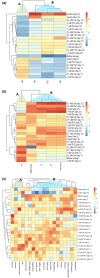Exogenous citric acid, salicylic acid, and putrescine treatments preserve the postharvest quality and physicochemical properties of broccoli (Brassica oleracea L. var. italica) during cold storage
- PMID: 38455170
- PMCID: PMC10916556
- DOI: 10.1002/fsn3.3862
Exogenous citric acid, salicylic acid, and putrescine treatments preserve the postharvest quality and physicochemical properties of broccoli (Brassica oleracea L. var. italica) during cold storage
Abstract
To extend the postharvest storage life of broccoli samples (Brassica oleracea L. var. italica), an exogenous application of citric acid (CA), salicylic acid (SA), and putrescine (PUT) was tested in multiple combinations (0.5 and 1 mM) at 4 ± 0.5°C and 90 ± 5% relative humidity (RH) for 21 days (d). The weight loss (WL), respiration rate (RR), total soluble solids (TSS), pH, color (L*, a*, b*, chroma, and hue angle), proximate and mineral contents, phenolic and flavonoid contents, and other biochemical properties of the treated and untreated broccoli samples were evaluated throughout the storage duration. The lowest WL was observed when exposed to 0.5 mM of PUT. 1 mM CA and PUT treatments were affected by RR, depending on storage conditions. The lowest TSS content was observed in broccoli samples treated with 0.5 mM CA among all treatments. The chroma value of the samples was preserved by the 0.5 mM SA treatment. The most abundant element in broccoli samples was potassium in the control application, followed by a 1 mM SA treatment. In addition, the protein content was the highest in the 1 mM PUT treatment. The highest vitamin C was determined in the 1 mM CA treatment, and the most abundant vanillic acid was found in broccoli exposed to the 0.5 mM and treatment. Glucose content was determined at the lowest level in the 0.5 mM SA treatment, while higher increases occurred in other treatments. In terms of these findings, 1 mM CA, 1 mM SA, and 1 mM PUT delay WL, RR, and color degradation and prolong the storage life of broccoli samples stored at 4 ± 0.5°C. It was concluded that the biochemical content, fresh weight, and green color of broccoli samples throughout postharvest and storage can be maintained longer by exogenous application of these natural compounds. Therefore, we recommend 1 mM PUT and 1 mM CA treatments to maintain the quality of broccoli by minimizing losses in morphological properties, mineral, and biochemical compositions during postharvest storage.
Keywords: broccoli sample; color properties; flavonoid; mineral composition; phenolic.
© 2023 The Authors. Food Science & Nutrition published by Wiley Periodicals LLC.
Conflict of interest statement
The authors declare that they do not have any conflicts of interest.
Figures


Similar articles
-
Exogenous Postharvest Application of Calcium Chloride and Salicylic Acid to Maintain the Quality of Broccoli Florets.Plants (Basel). 2022 Jun 5;11(11):1513. doi: 10.3390/plants11111513. Plants (Basel). 2022. PMID: 35684286 Free PMC article.
-
Foliar application of salicylic acid and calcium chloride delays the loss of chlorophyll and preserves the quality of broccoli during storage.J Food Biochem. 2022 Aug;46(8):e14154. doi: 10.1111/jfbc.14154. Epub 2022 Apr 5. J Food Biochem. 2022. PMID: 35383976
-
Different postharvest strategies to preserve broccoli quality during storage and shelf life: controlled atmosphere and 1-MCP.Food Chem. 2013 May 1;138(1):564-73. doi: 10.1016/j.foodchem.2012.09.143. Epub 2012 Nov 10. Food Chem. 2013. PMID: 23265525
-
Brassica oleracea var italica and Their By-Products as Source of Bioactive Compounds and Food Applications in Bakery Products.Foods. 2024 Nov 2;13(21):3513. doi: 10.3390/foods13213513. Foods. 2024. PMID: 39517297 Free PMC article. Review.
-
Physio-Metabolic Mechanisms Behind Postharvest Quality Deterioration in Broccoli (Brassica oleracea var. Italica) and Swiss Chard (Beta vulgaris L. var. Cicla): A Review.Plants (Basel). 2024 Nov 12;13(22):3174. doi: 10.3390/plants13223174. Plants (Basel). 2024. PMID: 39599383 Free PMC article. Review.
Cited by
-
Comparative Effects of Putrescine, Salicylic Acid, Citric Acid, and Methyl Jasmonate on Postharvest Quality and Storage Life of Pleurotus ostreatus.Food Sci Nutr. 2025 Apr 30;13(5):e70233. doi: 10.1002/fsn3.70233. eCollection 2025 May. Food Sci Nutr. 2025. PMID: 40313797 Free PMC article.
References
-
- Abdel‐Hamid, A. N. (2020). Changes in post‐harvest quality of menthe and sage fresh cut herbs treated with citric acid, salicylic acid and chitosan under cold storage. Middle East Journal of Agriculture Research, 9, 134–148. 10.36632/mejar/2020.9.1.14 - DOI
-
- Ahmad, A. , & Ali, A. (2019). Improvement of postharvest quality, regulation of antioxidants capacity and softening enzymes activity of cold‐stored carambola in response to polyamines application. Postharvest Biology and Technology, 148, 208–217. 10.1016/j.postharvbio.2018.10.017 - DOI
-
- Ahvenainen, R. (1996). New approaches in improving the shelf life of minimally processed fruit and vegetables. Trends in Food Science and Technology, 7, 179–187. 10.1016/0924-2244(96)10022-4 - DOI
-
- Alali, F. A. , Sarcheshmeh, M. A. A. , & Babalar, M. (2023). Evaluating the effects of citric acid application on reducing decay, maintaining edibility and shelf life of peach fruits in cold storage. International Journal of Horticultural Science, 10(3), 149–160.
LinkOut - more resources
Full Text Sources

